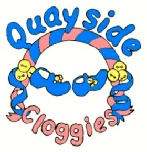
North West Clog-Morris is probably the most colourful of English dances. The elaborate costumes, together with the large number of dancers that take part, provide a show which stands out among crowds and noisy streets. Costumes are often decorated by rosettes, ribbons, strings of beads and badges. Clogs are almost always worn, with brass nails and eyelets and bells attached to the laces.
The Clog-Morris dances originate in Lancashire and Cheshire where women would dance in the street wearing clogs. In the mills, workers had to wear wooden soled shoes (leather soles rotted on the floors which were kept wet to keep the air humid), so people took their inspiration for the dance from the clatter of weaving machines and used their working shoes on the newly paved streets.
The heyday of the Morris in the North-West seems to have been the first half of the 19th century. The dancers regularly accompanied the rush cart to the Church at the annual Wakes Holiday in the late Summer. For a long time, this form of Morris dancing has been a processional dance, performed whilst moving along the streets. It is worth noting that in Lancashire the procession was, and in some areas still is, a favourite form of celebration. Even today the Whit Walks and annual carnival parades of the Lancashire‚ towns echo this fondness for processions. It is not surprising that the Morris fits in well with these occasions.
During the nineteenth century there was a growing opposition to the drunkenness and fighting that often accompanied the rush cart processions. However, times have changed. The Morris teams were decimated by the Great War and the changes that it brought with it. Fortunately, during the 1920's, girls and women's teams became predominant in the north-west and since the 1930's many mixed teams have survived.
North West Clog-Morris follows the same general pattern wherever it is found. However, versions performed by different teams vary considerably and it is usual to refer to these versions by the name of the place where they were collected or performed. There are many traditional dances identified by their places of origin such as Fleetwood, Colne and Lostock.
Our Dance Tradition
North West Clog-Morris
| Videos |